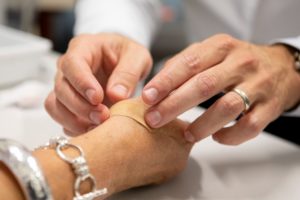 Will injections fix my shoulder, elbow, or hand problem?
Will injections fix my shoulder, elbow, or hand problem?
Steroid injections are commonly used in the treatment of shoulder, elbow and hand problems. As a result, there is some confusion about what these injections actually do for different conditions.
As a general rule, orthopedic surgeons such as Dr. Nelson use steroid injections for 3 main reasons:
1) To completely cure a condition, now and forever
2) To help relieve inflammation and pain that is unbearable for the patient, even if temporary
3) To help clarify exactly what condition the patient has and what structure is bothering them
What conditions can be completely cured with steroid injections?
Although we can never know and predict with 100% certainty that the steroid injection will cure a certain patient’s condition, we know that some conditions can be cured with a steroid injection. Problems that have high rates of cure with injection include tendinitis around the hand and wrist, including trigger finger. Problems with lower rates of cure include tennis and golfer’s elbow and shoulder biceps tendinitis, for example. Of course, the steroid injections are often administered along with recommendations for a period of rest, possibly bracing and icing, or physical therapy, which also may help the condition resolve.
Okay, so what conditions cannot be cured with steroid injections?
One of the most common reasons to perform injections around joints is arthritis, or wear and tear of the joint surface. It is important to understand that the steroid injection does not fix or reverse the arthritis. Arthritis is always there, and in fact tends to progress with time, no matter what you do. The main reason to perform injections for problems like wrist, hand, or shoulder arthritis is to “kick the can down the road,” temporarily reducing pain so that the patient can remain active, participate in physical therapy, and avoid resorting to surgical intervention.
Nerve problems also usually cannot be cured with steroid injections. For example, carpal tunnel syndrome is very common, and injections are often used to help reduce patient’s symptoms, especially if the carpal tunnel syndrome is due to a new or recent activity and the patient is not able to undergo a carpal tunnel release. But usually the carpal tunnel symptoms will usually return after a time.
So how can injections help clarify the cause of pain?
Sometimes even the best orthopedic surgeon has difficulty knowing with 100% certainty what structure is the cause of pain, or what the correct diagnosis is. Sometimes a good option is to perform an injection to clarify if a certain structure is the cause of pain. If an injection of steroid around the structure make the pain go away, even for a short time, this tells the patient and surgeon the injected structure is likely the cause. We also know that patients who have relief of their carpal tunnel symptoms, even temporarily, after injections are very likely to respond favorably to a carpal tunnel release with permanent relief of their symptoms.


